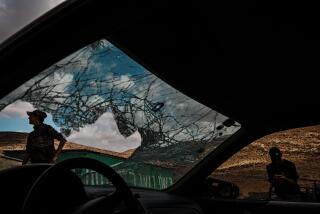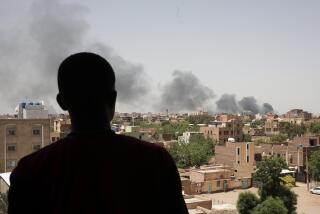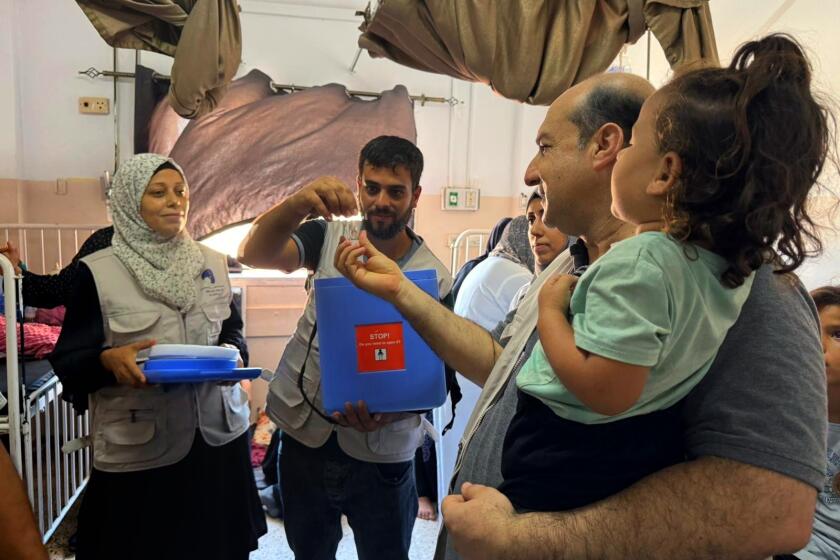U.S. Troops Sweep Key Somali City : Africa: Search for weapons turns up only one rifle, demonstrating military’s limitations.
AFGOI, Somalia — Hundreds of helicopter-borne U.S. troops swept this key crossroads city for weapons at twilight Saturday in a mission showing their prowess and the limitations put on what the U.S. military can do in Somalia.
By 9 p.m., the soldiers of the Army’s 10th Mountain Division had found a single World War II-vintage Enfield rifle--one voluntarily turned in by a resident. But their operation could last as long as four days.
Officers from the division based at Ft. Drum, N.Y., said they had deliberately sacrificed the element of surprise in order to spare potential civilian casualties in this humble town of one-story adobe houses and dirt paths.
Afgoi, which is crossed by a road that is an important supply artery for Somalia’s famine victims, was showered three days ago with leaflets tossed from helicopters to let people know a raid was coming soon. Leaders in the community of 40,000 were also contacted to identify locations of potential arms caches.
“You would have to be incredibly obtuse not to know that we were coming,” Maj. Martin Stanton of Orlando, Fla., said. “It’s obviously a success if we find a great deal of weapons. But it also really is a success if we can scare some bandits into not being bandits, if we can make this place safer and if none of my people gets hurt.”
Other Army officers said another important goal was to lay down a “big footprint” and demonstrate convincingly that the 22-nation U.S.-led coalition now in Somalia could strike with massive force anywhere.
As a pair of donkeys grazed impassively near a brick-walled farming compound and the sun sank in the sky, six Army Black Hawk helicopters roared in from the west and deposited 11 soldiers apiece on a dusty patch near a cornfield ready for harvest.
A bit more than a mile away, on the other side of Afgoi, 11 more Black Hawks were unloading troops to form a cordon around the town. Still more soldiers attired in the same tan, desert-style battle dress used during Operation Desert Storm arrived by motor convoy.
Mohamed Hasan Aden, 38, an Afgoi resident, walked out on a rutted dirt track partially filled with stagnant water to watch. He spoke only a little English but managed to say that there were 50 “bad people” with guns in his town. He said he was happy to see the Americans.
Afgoi is connected by a paved road that runs past thick clusters of prickly pear and flat-topped aspen trees to Mogadishu, Somalia’s capital and main port about 25 miles away.
To reach the famine-stricken areas of Baidoa and Bardera, as well as the coastal road that heads south to the refugee camps at Kismayu, relief convoys must travel through Afgoi. U.S. military officials said they had decided on the dragnet operation because of a resumption of looting and banditry.
“We have problems on the road,” agreed Abdi Aden Jamma, 65, a retiree encountered about five miles from Afgoi as a group of journalists waited for the operation to begin. “We need them (the Americans) to take all of the munitions from all of the people.”
The air was heavy with the smell of manure and warm earth, and the sky was tinted orange by the setting sun when the soldiers began to move slowly through the outskirts of the town.
Bullhorns mounted on a Humvee told residents in Somali, “The Americans want to help you, and you have to help them.” The message asked people to go back to their homes, and scores of gawking children were shooed inside by parents.
Having sacrificed the element of surprise, the U.S. troops were further bound by the rules of engagement imposed on them during Operation Restore Hope.
Barred from replacing Somalia’s nonexistent police force, they have no formal arrest powers, and unless there are aggravating circumstances, they are not supposed to enter private homes in search of weapons.
“Our mission is to go through all alleys and streets,” Capt. Wesley Bickford of Windsor, Vt., commander of Bravo Company, 2nd Battalion, 82nd Infantry Regiment, explained. “That is the only place we are allowed to patrol.”
When asked if, under such strictures, U.S. soldiers could ferret out bandits or people who have weapons in violation of a cease-fire agreement between Somalia’s numerous warlords, Lt. Guy LaVeille of Somersworth, N.H., answered: “That’s a good question. That’s why we’re setting up that security force.”
Somalia’s police are supposed to be revived with American assistance this week.
Soldiers wore night-vision goggles, similar to the magnifying glasses worn by a watchmaker or jeweler, and two circling helicopters beamed infrared beacons earthward to try and spot locations of suspected arms caches.
There was a brief pop-pop of small-arms fire and two rounds of orange tracer, but soldiers disagreed about the origin. Maj. Marty Culp, the public information officer of the 10th Division, said there was no doubt they had come under sniper fire from somewhere.
The evening’s tensest moment turned out to be little more than a farce, although the soldiers could not have known it at the time. As a patrol moved about 200 yards from one end of the town to the other, it spotted a group of villagers who tried to duck into a house.
The Americans fired orange flares to light up the area, and the entrance of the house was rapidly surrounded by troops carrying M-16s and M-60 machine guns. The 21 people inside were ordered onto the dirt street, made to sit down and then interrogated.
Far from being bandits, it turned out that they had been having a communal chew of qat, a green leaf consumed in Somalia for its mild narcotic properties.
A good sport, the homeowner, Usef Momen, 36, a former employee of now-bankrupt Somalia Airways, said he thought it was a “good idea” that the Americans had come. But he said that as far as he knew, there had been no acts of banditry here over the past two or three days.
More to Read
Sign up for Essential California
The most important California stories and recommendations in your inbox every morning.
You may occasionally receive promotional content from the Los Angeles Times.









